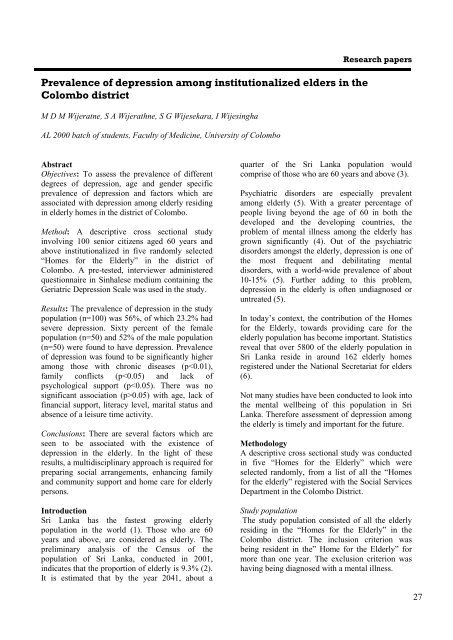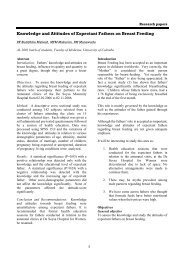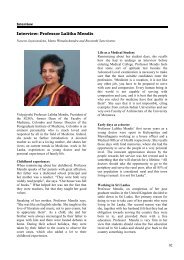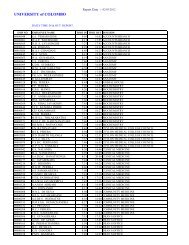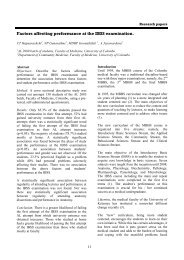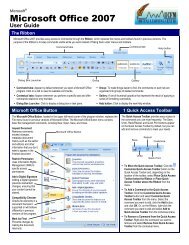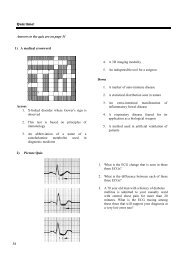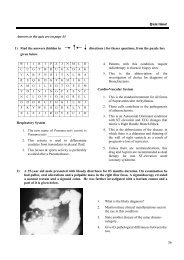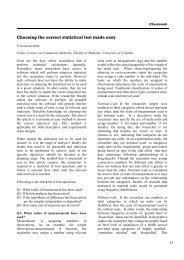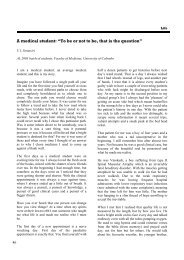Prevalence of depression among institutionalized elders in the ...
Prevalence of depression among institutionalized elders in the ...
Prevalence of depression among institutionalized elders in the ...
Create successful ePaper yourself
Turn your PDF publications into a flip-book with our unique Google optimized e-Paper software.
<strong>Prevalence</strong> <strong>of</strong> <strong>depression</strong> <strong>among</strong> <strong><strong>in</strong>stitutionalized</strong> <strong>elders</strong> <strong>in</strong> <strong>the</strong><br />
Colombo district<br />
M D M Wijeratne, S A Wijerathne, S G Wijesekara, I Wijes<strong>in</strong>gha<br />
AL 2000 batch <strong>of</strong> students, Faculty <strong>of</strong> Medic<strong>in</strong>e, University <strong>of</strong> Colombo<br />
Research papers<br />
Abstract<br />
Objectives: To assess <strong>the</strong> prevalence <strong>of</strong> different<br />
degrees <strong>of</strong> <strong>depression</strong>, age and gender specific<br />
prevalence <strong>of</strong> <strong>depression</strong> and factors which are<br />
associated with <strong>depression</strong> <strong>among</strong> elderly resid<strong>in</strong>g<br />
<strong>in</strong> elderly homes <strong>in</strong> <strong>the</strong> district <strong>of</strong> Colombo.<br />
Method: A descriptive cross sectional study<br />
<strong>in</strong>volv<strong>in</strong>g 100 senior citizens aged 60 years and<br />
above <strong><strong>in</strong>stitutionalized</strong> <strong>in</strong> five randomly selected<br />
“Homes for <strong>the</strong> Elderly” <strong>in</strong> <strong>the</strong> district <strong>of</strong><br />
Colombo. A pre-tested, <strong>in</strong>terviewer adm<strong>in</strong>istered<br />
questionnaire <strong>in</strong> S<strong>in</strong>halese medium conta<strong>in</strong><strong>in</strong>g <strong>the</strong><br />
Geriatric Depression Scale was used <strong>in</strong> <strong>the</strong> study.<br />
Results: The prevalence <strong>of</strong> <strong>depression</strong> <strong>in</strong> <strong>the</strong> study<br />
population (n=100) was 56%, <strong>of</strong> which 23.2% had<br />
severe <strong>depression</strong>. Sixty percent <strong>of</strong> <strong>the</strong> female<br />
population (n=50) and 52% <strong>of</strong> <strong>the</strong> male population<br />
(n=50) were found to have <strong>depression</strong>. <strong>Prevalence</strong><br />
<strong>of</strong> <strong>depression</strong> was found to be significantly higher<br />
<strong>among</strong> those with chronic diseases (p
Sample size<br />
100 elderly <strong>in</strong>dividuals, resid<strong>in</strong>g <strong>in</strong> 5 randomly<br />
selected “Homes for <strong>the</strong> Elderly” <strong>in</strong> <strong>the</strong> Colombo<br />
district.<br />
Sampl<strong>in</strong>g Method<br />
The sampl<strong>in</strong>g frame consisted <strong>of</strong> all “Homes for<br />
<strong>the</strong> Elderly” registered with <strong>the</strong> National<br />
Secretariat for <strong>the</strong> Elderly <strong>in</strong> <strong>the</strong> district <strong>of</strong><br />
Colombo. Five “Homes for <strong>the</strong> Elderly” were<br />
selected us<strong>in</strong>g simple random sampl<strong>in</strong>g. A list <strong>of</strong><br />
all <strong>the</strong> members fulfill<strong>in</strong>g our <strong>in</strong>clusion &<br />
exclusion criteria from <strong>the</strong> above selected “Homes<br />
for <strong>the</strong> Elderly” was prepared and stratified<br />
accord<strong>in</strong>g to gender (male & female). Fifty<br />
<strong>in</strong>dividuals were selected from each stratum by<br />
simple random sampl<strong>in</strong>g (50 males and 50<br />
females) as <strong>the</strong> study sample.<br />
Study <strong>in</strong>strument<br />
Data was collected us<strong>in</strong>g a pre-tested, <strong>in</strong>terviewer<br />
adm<strong>in</strong>istered questionnaire <strong>in</strong> S<strong>in</strong>halese medium,<br />
consist<strong>in</strong>g <strong>of</strong> two parts.<br />
Part A: It is <strong>the</strong> S<strong>in</strong>halese version <strong>of</strong> <strong>the</strong> Geriatric<br />
Depression Scale (GDS), an <strong>in</strong>ternationally<br />
accepted standardized questionnaire (7). It’s a 15-<br />
item questionnaire especially developed as a<br />
screen<strong>in</strong>g <strong>in</strong>strument <strong>of</strong> depressive symptoms <strong>in</strong><br />
<strong>the</strong> elderly to which <strong>the</strong>y respond by <strong>in</strong>dicat<strong>in</strong>g<br />
“yes” or “no” answers (7).<br />
It was orig<strong>in</strong>ally formulated <strong>in</strong> English and for <strong>the</strong><br />
purpose <strong>of</strong> this study, it was translated <strong>in</strong>to<br />
S<strong>in</strong>halese and back translated <strong>in</strong>to English to<br />
m<strong>in</strong>imize <strong>in</strong>consistencies (The S<strong>in</strong>halese version<br />
was used <strong>in</strong> <strong>the</strong> study).<br />
A Depression Score was given out <strong>of</strong> 15 <strong>in</strong> order<br />
to categorize <strong>the</strong> study population <strong>in</strong>to no<br />
<strong>depression</strong>, mild <strong>depression</strong> or severe <strong>depression</strong>.<br />
GDS is an <strong>in</strong>ternationally validated questionnaire<br />
show<strong>in</strong>g a sensitivity <strong>of</strong> 85% and specificity <strong>of</strong><br />
74% (7).Based on <strong>the</strong> research that used<br />
<strong>depression</strong> rat<strong>in</strong>g scales <strong>in</strong> <strong>the</strong> elderly population,<br />
it is clear that GDS is <strong>the</strong> best validated <strong>in</strong>strument<br />
<strong>in</strong> various geriatric populations (7).<br />
Part B: A s<strong>in</strong>gle paged questionnaire <strong>in</strong>tended to<br />
elicit socio-demographic <strong>in</strong>formation <strong>of</strong> <strong>the</strong> study<br />
population (i.e., age, gender, nationality, religion,<br />
marital status, level <strong>of</strong> education, past occupation,<br />
<strong>in</strong>formation on leisure time activities done <strong>in</strong> <strong>the</strong><br />
elderly home, psychological & f<strong>in</strong>ancial support<br />
from family members and friends.) “Psychological<br />
support” was taken as any visits or communication<br />
with a relative, friend or any o<strong>the</strong>r known person.<br />
“F<strong>in</strong>ancial support” was taken as, a relative, friend<br />
or any o<strong>the</strong>r known person giv<strong>in</strong>g money to <strong>the</strong><br />
<strong>in</strong>dividual.<br />
The questionnaire was adm<strong>in</strong>istered by <strong>the</strong><br />
<strong>in</strong>vestigators by <strong>in</strong>terview<strong>in</strong>g <strong>the</strong> respondents at<br />
<strong>the</strong>ir bed side. A standard method was used to<br />
conduct <strong>the</strong> <strong>in</strong>terviews to m<strong>in</strong>imize <strong>in</strong>terviewer<br />
bias. Verbal consent was obta<strong>in</strong>ed from<br />
respondents and <strong>the</strong>ir caregivers prior to<br />
adm<strong>in</strong>ister<strong>in</strong>g <strong>the</strong> questionnaire.<br />
Data was collected over a period <strong>of</strong> five days<br />
dur<strong>in</strong>g <strong>the</strong> morn<strong>in</strong>g hours <strong>in</strong> order to m<strong>in</strong>imize<br />
<strong>in</strong>terference to <strong>the</strong> activities at <strong>the</strong> elderly homes.<br />
Before conduct<strong>in</strong>g <strong>the</strong> research, permission from<br />
<strong>the</strong> directors <strong>of</strong> <strong>the</strong> relevant “Homes for <strong>the</strong><br />
Elderly” was obta<strong>in</strong>ed. Anonymity <strong>of</strong> respondents<br />
and confidentiality <strong>of</strong> <strong>in</strong>formation were assured.<br />
Thus <strong>the</strong> names and date <strong>of</strong> birth were not<br />
<strong>in</strong>cluded <strong>in</strong> <strong>the</strong> questionnaire. Respondents were<br />
given <strong>the</strong> provision to refra<strong>in</strong> from answer<strong>in</strong>g any<br />
questions. All data collected was considered<br />
confidential, and only <strong>the</strong> <strong>in</strong>vestigators handled <strong>the</strong><br />
data.<br />
Data was analyzed manually and statistical<br />
methods (Chi square tests, P values) were used to<br />
carry out <strong>in</strong>ternal comparisons.<br />
Results<br />
Response rate was 100%. More than half (53%) <strong>of</strong><br />
our sample was between <strong>the</strong> ages <strong>of</strong> 60 to 69<br />
years. The mean age <strong>of</strong> <strong>the</strong> sample was 69.9 years.<br />
In <strong>the</strong> sample <strong>the</strong> majority were S<strong>in</strong>halese (96%).<br />
Eighty five percent <strong>of</strong> <strong>the</strong> sample was Buddhists.<br />
Twenty eight percent had never got married. Ten<br />
percent had a liv<strong>in</strong>g spouse. More than half <strong>of</strong> <strong>the</strong><br />
elderly <strong>in</strong> <strong>the</strong> sample (55%) were widowed.<br />
Among <strong>the</strong> unmarried 67.86% were males. All<br />
who were separated or divorced were females.<br />
Only 4% <strong>of</strong> <strong>the</strong> sample had not attended school<br />
dur<strong>in</strong>g <strong>the</strong>ir lifetime. Seven percent had cont<strong>in</strong>ued<br />
<strong>the</strong>ir education up to <strong>the</strong> Advanced Level. Literacy<br />
rate <strong>of</strong> <strong>the</strong> sample was 56% (An <strong>in</strong>dividual was<br />
considered literate if he or she can read and write<br />
/and went to school at least up to year 5 ). In our<br />
study, 39% <strong>of</strong> <strong>the</strong> elderly were not employed<br />
dur<strong>in</strong>g any stage <strong>of</strong> <strong>the</strong>ir life and all <strong>of</strong> <strong>the</strong>m were<br />
females whereas all <strong>the</strong> males had been employed.<br />
28
Table 1: Socio-demographic characteristics <strong>of</strong> <strong>the</strong> study population<br />
Number <strong>of</strong> elderly<br />
(n=100) %<br />
Age category (Years)<br />
60 – 69 53 53%<br />
70 – 79 40 40%<br />
≥ 80 7 07%<br />
Ethnicity<br />
S<strong>in</strong>halese 96 96%<br />
O<strong>the</strong>r 4 04%<br />
Religion<br />
Buddhist 85 85%<br />
Catholic & Christian 13 13%<br />
H<strong>in</strong>du 2 2%<br />
Marital status<br />
Never married 10 10%<br />
Widowed 55 55%<br />
Divorced/separated 28 28%<br />
Currently married 7 7%<br />
Educational status<br />
No school<strong>in</strong>g 4 04%<br />
Year 1- 5 40 40%<br />
Year 6-11 49 49%<br />
Completed Advanced Level 6 6%<br />
Higher education 1 1%<br />
The GDS was used to assess <strong>the</strong> presence and <strong>the</strong><br />
severity <strong>of</strong> <strong>depression</strong> <strong>in</strong> <strong>the</strong> sample. Those who<br />
obta<strong>in</strong>ed a score <strong>of</strong> more than 4 out <strong>of</strong> 15 were<br />
classified as hav<strong>in</strong>g <strong>depression</strong> accord<strong>in</strong>g to <strong>the</strong><br />
GDS. The depressed group was subdivided <strong>in</strong>to<br />
mild and severe <strong>depression</strong>. A score <strong>of</strong> 5 to 10 was<br />
considered as mild <strong>depression</strong> whereas a score <strong>of</strong><br />
11 or more was regarded as severe <strong>depression</strong>. The<br />
mode <strong>of</strong> <strong>the</strong> <strong>depression</strong> score <strong>in</strong> <strong>the</strong> study was 9/15<br />
and <strong>the</strong> mean score was 6.06.<br />
Table 2: <strong>Prevalence</strong> <strong>of</strong> different degrees <strong>of</strong> <strong>depression</strong>.<br />
Severity <strong>of</strong> Depression<br />
Males<br />
No (%)<br />
Females<br />
No (%)<br />
Total<br />
No (%)<br />
No Depression 24 (48) 20 (40) 44 (44)<br />
Mild Depression 20 (40) 23 (46) 43 (43)<br />
Severe <strong>depression</strong> 6 (12) 7 (14) 13 (13)<br />
Total 50 (100) 50 (100) 100 (100)<br />
Out <strong>of</strong> <strong>the</strong> 100 <strong>in</strong> <strong>the</strong> sample, a majority (56%)<br />
were depressed. Twenty six males (52%) and<br />
30(60%) females had <strong>depression</strong>. Out <strong>of</strong> <strong>the</strong><br />
depressed population, 46.42% were males and<br />
53.57% were females (Χ 2 (df) = 0.64, p>0.05).<br />
Fifty percent <strong>of</strong> depressed <strong>in</strong>dividuals belong to<br />
<strong>the</strong> age category 60-69 years.<br />
29
percentage <strong>of</strong> elderly<br />
Number<br />
Figure 1: Reasons for admission to “Homes for Elderly”<br />
25%<br />
20%<br />
15%<br />
10%<br />
5%<br />
9%<br />
7%<br />
8%<br />
4%<br />
5%<br />
16%<br />
14%<br />
20%<br />
8%<br />
9%<br />
0%<br />
Loss <strong>of</strong> spouse<br />
F<strong>in</strong>ancial<br />
difficulties<br />
Family<br />
conflicts<br />
Absence <strong>of</strong> a<br />
caregiver<br />
voluntarily<br />
Reason for com<strong>in</strong>g to "Home for elderly"<br />
Not depressed<br />
Depressed<br />
The most common reason (34%) for admission<br />
was absence <strong>of</strong> a care- giver. (Some had more<br />
than one reason and <strong>the</strong> most <strong>in</strong>fluential reason<br />
was taken <strong>in</strong> <strong>the</strong> study)<br />
<strong>Prevalence</strong> <strong>of</strong> <strong>depression</strong> was higher <strong>among</strong> those<br />
who came to <strong>the</strong> “Homes for <strong>the</strong> Elderly due to<br />
family conflicts (Χ 2 (df) = 4.398, p0.05 ),<br />
compared to o<strong>the</strong>r reasons for admission.<br />
Figure 2: Presence or absence <strong>of</strong> psychological support and <strong>depression</strong> <strong>in</strong> <strong>the</strong> sample<br />
35%<br />
30%<br />
25%<br />
20%<br />
15%<br />
10%<br />
5%<br />
0%<br />
32%<br />
28% 28%<br />
present<br />
psychological support<br />
absent<br />
12%<br />
A majority (60%) <strong>of</strong> <strong>the</strong> sample had psychological<br />
support, whereas 40% did not. Seventy percent <strong>of</strong><br />
those who did not have psychological support<br />
were depressed (Χ 2 (df) = 5.30, p0.05). All depressed males <strong>in</strong> <strong>the</strong> study<br />
population were previously employed whereas a<br />
majority (76.7%) <strong>of</strong> females with <strong>depression</strong> were<br />
previously unemployed (SND= 0.282, p>0.05).<br />
Of those who are depressed, a majority<br />
53(94.64%) were currently unmarried ( SND =<br />
1.23, p>0.05). Currently unmarried group <strong>in</strong>cludes<br />
Depressed<br />
Not depressed<br />
widowed, separated, divorced and never married<br />
<strong>in</strong>dividuals. Out <strong>of</strong> those depressed (n=56),<br />
25(44.64%) were illiterate (Χ 2 (df) = 0.021,<br />
p>0.05). Only 9(16.7%) <strong>of</strong> depressed <strong>in</strong>dividuals<br />
were lack<strong>in</strong>g a leisure time activity (SND= 1.3,<br />
p>0.05), whereas a majority were occupied <strong>in</strong> such<br />
activities. From <strong>the</strong> total depressed population<br />
41(73.21%) were hav<strong>in</strong>g various chronic diseases<br />
(Χ 2 (df) = 7.184, p
Discussion<br />
S<strong>in</strong>ce research on geriatric psychiatry <strong>in</strong> Sri Lanka<br />
is sparse, <strong>the</strong> Sri Lankan figures <strong>of</strong> prevalence <strong>of</strong><br />
<strong>depression</strong> <strong>among</strong> <strong>the</strong> elderly could not be<br />
obta<strong>in</strong>ed. Accord<strong>in</strong>g to global figures <strong>the</strong><br />
prevalence <strong>of</strong> <strong>depression</strong> <strong>among</strong> elderly was 10-<br />
15% (5). In <strong>the</strong> present sample, severity was<br />
assessed us<strong>in</strong>g <strong>the</strong> GDS. The mean score was<br />
6.06/15 and <strong>the</strong> mode was 9/15. A majority<br />
(76.78%) were hav<strong>in</strong>g mild <strong>depression</strong>.<br />
A study done <strong>in</strong> Turkey to estimate <strong>the</strong> prevalence<br />
<strong>of</strong> <strong>depression</strong> <strong>among</strong> <strong><strong>in</strong>stitutionalized</strong> elderly,<br />
found that 58.3% <strong>of</strong> <strong>the</strong> total study population was<br />
hav<strong>in</strong>g depressive symptoms (45.1% <strong>in</strong> males and<br />
54.9% <strong>in</strong> females) (8). Literature states that<br />
women are twice as likely to suffer from<br />
<strong>depression</strong> as men as <strong>the</strong> result <strong>of</strong> hormonal<br />
changes result<strong>in</strong>g from menstruation, pregnancy<br />
and menopause (9). The above statistics closely<br />
match <strong>the</strong> results <strong>of</strong> our study <strong>in</strong> which <strong>the</strong><br />
prevalence <strong>of</strong> <strong>depression</strong> was 56% (n=100) <strong>in</strong> <strong>the</strong><br />
total sample with a female preponderance (46.4%<br />
<strong>in</strong> males vs. 53.6% <strong>in</strong> females). However, <strong>the</strong><br />
female preponderance was not statistically<br />
significant (p > 0.05).<br />
More than a half <strong>of</strong> our sample was aged between<br />
60 to 69 years (mean age 69.9 years). Depression<br />
was more prevalent <strong>among</strong> elderly aged 60-69<br />
years. However, <strong>the</strong> <strong>in</strong>dividuals’ age was not seen<br />
to be significantly associated with <strong>depression</strong>.<br />
Depression is caused by a chemical imbalance <strong>in</strong><br />
<strong>the</strong> bra<strong>in</strong>. The exact mechanism is unknown, but<br />
bouts <strong>of</strong> <strong>depression</strong> can be triggered by sad or<br />
stressful life events, hormonal changes, disease, or<br />
certa<strong>in</strong> medications. People with low self-esteem<br />
and a pessimistic outlook on life, seem to be<br />
particularly prone to <strong>depression</strong> (9). S<strong>in</strong>ce marital<br />
status, leisure activities, psychological and<br />
f<strong>in</strong>ancial support, can be considered as factors<br />
which may contribute towards mental well-be<strong>in</strong>g,<br />
<strong>the</strong> study was carried out with an objective to f<strong>in</strong>d<br />
any association <strong>of</strong> <strong>the</strong>se factors with <strong>depression</strong>.<br />
Majority (73.21%) had chronic diseases, <strong>the</strong><br />
presence <strong>of</strong> which was significantly associated<br />
with <strong>depression</strong>. Absence <strong>of</strong> psychological support<br />
was significantly associated with <strong>depression</strong>.<br />
The most common two reasons for admission to<br />
“Homes for <strong>the</strong> Elderly” were absence <strong>of</strong> a<br />
caregiver and family conflicts (with children, <strong>in</strong>laws,<br />
grand children etc. Of <strong>the</strong> above two<br />
reasons, family conflicts had a statistically<br />
significant association with <strong>the</strong> occurrence <strong>of</strong><br />
<strong>depression</strong>. Depression was not significantly<br />
associated with marital status, f<strong>in</strong>ancial support or<br />
employment status with <strong>depression</strong>.<br />
The elderly <strong>in</strong> our sample has had a reasonably<br />
good level <strong>of</strong> school<strong>in</strong>g, with a literacy rate <strong>of</strong><br />
56%. Though some studies have shown that low<br />
literacy level is a risk factor for <strong>depression</strong> <strong>in</strong> <strong>the</strong><br />
elderly, <strong>the</strong>re was no statistically significant<br />
association between <strong>the</strong> existence <strong>of</strong> <strong>depression</strong><br />
and literacy level <strong>in</strong> our study sample.<br />
Conclusion<br />
In our study <strong>the</strong> prevalence <strong>of</strong> <strong>depression</strong> was 56%<br />
with a female preponderance (53.6%). Absence <strong>of</strong><br />
psychological support, presence <strong>of</strong> chronic<br />
diseases and family conflicts had a statistically<br />
significant association with <strong>the</strong> occurrence <strong>of</strong><br />
<strong>depression</strong> <strong>in</strong> <strong>the</strong> study sample. Depression<br />
<strong>among</strong> <strong><strong>in</strong>stitutionalized</strong> elderly is an important<br />
timely issue <strong>of</strong>ten undiagnosed and untreated,<br />
which needs to be addressed. In <strong>the</strong> light <strong>of</strong> <strong>the</strong><br />
results <strong>of</strong> this paper, a multidiscipl<strong>in</strong>ary approach<br />
is required for prepar<strong>in</strong>g social arrangements<br />
enhanc<strong>in</strong>g family and community support and<br />
home care for elderly <strong>in</strong>dividuals.<br />
References<br />
1. Siddhisena KAP. Mortality trends, determ<strong>in</strong>ants and<br />
implications <strong>in</strong> Sri Lanka: Retrospect and prospect. In:<br />
Demography <strong>of</strong> Sri Lanka: Issues and challenges.<br />
Department <strong>of</strong> Demography, University <strong>of</strong> Colombo, Sri<br />
Lanka. 2000. p. 119-31.<br />
2. Department <strong>of</strong> Health Services, Sri Lanka. Annual<br />
Health Bullet<strong>in</strong>. Colombo, 2002.<br />
3. M<strong>in</strong>istry <strong>of</strong> Health. Population Division. Emerg<strong>in</strong>g<br />
population issues <strong>in</strong> Sri Lanka, M<strong>in</strong>istry <strong>of</strong> Health,<br />
Colombo, 1993.<br />
4. David CS. <strong>Prevalence</strong> <strong>of</strong> Depression and its Treatment <strong>in</strong><br />
an Elderly Population. Archives <strong>of</strong> General Psychiatry<br />
2000;57:601-7.<br />
5. Gelder M, Mayou R, Geddes J. Oxford Core Text <strong>of</strong><br />
Psychiatry. 2 nd ed. Oxford:Oxford University Press; 1999.<br />
6. Department <strong>of</strong> Social Services and National Secretariat<br />
for Elders, Sri Lanka. National Survey on Elders, 2003-<br />
2004. Colombo, 2005.<br />
7. Taylor MEH. Measur<strong>in</strong>g Depression <strong>in</strong> Elderly, What<br />
Scale is best. Journal <strong>of</strong> Gerontology 1998;53:12-8.<br />
8. M<strong>in</strong>e E. The prevalence <strong>of</strong> <strong>depression</strong> <strong>in</strong> elderly liv<strong>in</strong>g at<br />
homes <strong>in</strong> Eastern Turkey. International Journal <strong>of</strong><br />
Human Sciences;12:45-56.<br />
9. Mc Donald YG, Frankl<strong>in</strong> ERD. Psychiatric illnesses <strong>in</strong><br />
Elderly. Journal <strong>of</strong> Gerontology.1992;47:142-150.<br />
31


